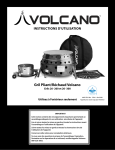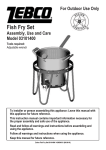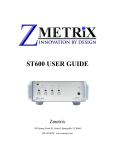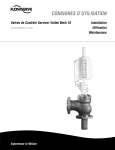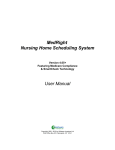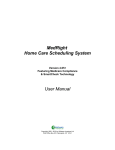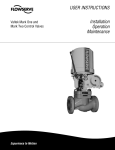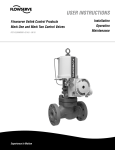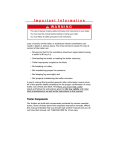Download Volcano II collapsible stove with propane attachment Instruction manual
Transcript
Volcano Collapsible Stove 20-200 and 20-300 Grills INSTRUCTIONS FOR USE For Outdoor Use Only IMPORTANT “This instruction manual contains important information necessary for the proper assembly and safe use of the appliance.” “Read and follow all warnings and instructions before assembling and using the appliance.” “Follow all warnings and instructions when using this appliance.” “Keep this manual for future reference.” If you have questions about assembly, operation, servicing or repair of this stove, please call Volcano at 888-320-2005. ANSI Z21.89a · CSA 1.18a-2008 Outdoor Cooking Specialty Gas Appliance 1 CONTENTS DANGER General Safety Information p. 2-3 Maintenance p. 10 To Set up p. 6 Troubleshooting p. 11 Leak Check p. 4-5 Service p. 11 1. Shut off gas to the appliance at the tank. Operation p. 7-8 Things You Should Know p. 11 2. Extinguish any open flame. To Light p. 8 Replacement Parts List p. 12 3. Before Cooking p. 8 Contents p. 6 & 13 If odor continues, keep away from the appliance and immediately call your fire department. After Cooking p. 8 Accessories p. 14 Tear Down/Clean p. 9-10 Warranty p. 16 Storage p. 10 DANGER 1. Never operate this appliance unattended. 2. Never operate this appliance within 10 ft. (3m) of any structure, combustible material or other gas cylinder. If you smell gas: Failure to follow these instructions could result in fire, explosion or burn hazard, which could cause property damage, personal injury or death. GENERAL CAUTIONS 1. Do NOT leave this appliance unattended while in use. The user must remain in the immediate area of the product and have a clear view of the product at all times during operation. 2. Keep children and pets away from burner at all times. 3. Never operate this appliance within 25 ft (7.5 m) of any flammable liquid. 3. The use of alcohol, prescription or non-prescription drugs may impair your ability to properly assemble or safely operate this appliance. 4. Never allow oil or grease to get hotter than 400°F or 200°C. If the temperature exceeds 400°F (200°C), or if oil begins to smoke, immediately turn burner or gas supply OFF. 4. For OUTDOOR use only. Do NOT use in a building, garage or any other enclosed area. Do NOT use in or on recreational vehicles or boats. NEVER use this appliance as a heater. 5. Heated liquids remain at scalding temperatures long after the cooking process. Never touch cooking appliance until liquids have cooled to 115°F (45°C) or less. 6. If a fire should occur, keep away from appliance and immediately call your fire department. Do not attempt to extinguish an oil or grease fire with water. Failure to follow these instructions could result in fire, explosion or burn hazard, which could cause property damage, personal injury or death. WARNING This product contains chemicals known to the State of California to cause cancer and birth defects or other reproductive harm. WARNING This appliance is not for frying turkeys. 5. Do not operate appliance under ANY overhead construction. Keep a minimum clearance of 10 feet (3 m) from the sides, front and back of appliance to ANY construction. Keep the area clear of all combustible material and flammable liquids, including wood, dry plants and grass, brush, paper and canvas. 6. Use ONLY on a level, stable, non-combustible surface like bricks, concrete or dirt. Do NOT use this appliance on any surface that will burn or melt like wood, asphalt, vinyl, or plastic. 7. Keep the fuel supply hose away from any heated surfaces. 8. To prevent accidental fires, before using the appliances ensure that the hose is not damaged and all joints and connections are not leaking by turning on the cylinder valve, leave the burner valve closed and apply a soapy solution to the joints and connections. If a continuous hissing sound is heard, or if the soapy solution bubbles, there is a leak. Do not use the appliance if there is a leak. Replace the faulty parts. 9. Extinguish all open flames before connecting the gas supply to the appliance and before checking for leaks. 10. When cooking with oil or grease, a thermometer MUST be used. 11. NEVER allow oil or grease temperature to get hotter than 400°F (200°C). If the temperature exceeds 400°F (200°C) or if oil begins to smoke, IMMEDIATELY turn burner off. 12. When cooking with oil or grease, fire extinguishing materials shall be readily accessible. In the event of an oil or grease fire DO NOT attempt to extinguish with water. Use a Type BC dry chemical fire extinguisher or smother fire with dirt, sand or baking soda. 13. NEVER overfill the cooking pot with oil, grease or water. Follow instructions in this manual for establishing proper oil, grease or water levels. 2 14. When frying with oil or grease, all food products MUST be completely thawed and towel dried to remove excess water. Failure to completely thaw and dry food may cause oil or grease to overflow. Follow instruction in this manual for frying foods. 15. When frying, slowly submerse food products into the oil or grease. Do NOT drop. 16. DO NOT place an empty cooking vessel on burner while in operation. Use caution when placing anything in the cooking vessel while burner is in operation. 17. In the event of rain, hail, sleet or other forms of precipitation, while cooking with oil or grease, IMMEDIATELY turn off burner(s) and gas supply, then cover cooking vessel. Do NOT attempt to move the appliance or the cooking vessel. 18. Avoid bumping or impact with the appliance to prevent spillage of splashing of hot cooking liquid. 19. Do NOT move the appliance when in use. Allow unit to cool to 115°F (45°C) before moving or storing. WARNING Combustion by-products produced when using this product contain chemicals known to the State of California to cause cancer, birth defects, or other reproductive harm. • Never operate appliance with LP tanks out of correct position specified in Assembly Instructions. • Always close LP tank valve and remove coupling nut before moving LP tank from specified operating position. 20. This appliance will be hot during and after use. Use insulated oven mitts or gloves for protection from hot surfaces or splatter from cooking liquids. 21. In case there is a fire, call the local fire department of dial 911. Stay clear from flames. Do not attempt to extinguish an oil or grease fire with water. 22. Use only accessories, such as cooking vessels recommended by the manufacturer, to allow safe and proper performance of the product. Never use a cooking vessel larger than the capacity and diameter recommended by the manufacturer. 23. This product is not intended for commercial use. 24. Always cover the appliance when not in use. 25. In the event the appliance has been exposed to water, tilt the appliance forward and allow water to drain from the burner before attempting to ignite. INSTALLATION SAFETY PRECAUTIONS • Use appliance only with LP (propane) gas and the regulator/valve assembly supplied. • Installation must conform with local codes, or in their absence with National Fuel Gas Code, NFPA 54/ANSI Z223.1. Handling and storage of LP cylinders must conform to LP Gas Code NFPA/ANSI 58. Appliance is not for use in or on recreational vehicle and/or boats. • Do not modify this appliance. Modifications will result in a safety hazard. Questions regarding certification in other areas may be addressed to 1-888-320-2005. • Apartment Dwellers: Check with management to learn the requirements and fire codes for using and LP Gas appliance at an apartment. If allowed, use outside on the ground floor with a 10 foot clearance from walls or tails. Do NOT use appliance on or under any apartment, condominium balcony or deck. • Before opening LP tank valve, check the coupling nut for tightness. When appliance is not in use, turn off control knob and LP tank valve on supply cylinder. • Never use LP tank if visibly rusted, damaged, or out of date. • If you notice grease or other hot material dripping from appliance onto valve, hose or regulator, turn off gas supply at once. Determine the cause, correct, clean and inspect valve, hose and regulator before continuing. Perform a leak test. • The regulator may have a humming or whistling noise during operation. This will not affect the safety or use of appliance. • Clean and inspect the hose before each use of the appliance. If there is evidence of abrasion, wear, cuts or leaks, the hose must be replaced prior to the appliance being put into operation. See product sheet for hose and regulator information. • Do not block holes in bottom or sides of appliance. WARNING Hose is a trip hazard. • NEVER store a spare LP tank under or near appliance or in enclosed areas. NEVER fill the cylinder beyond 80% full. An overfilled spare LP tank is hazardous due to possible gas released from the safety relief valve. Failure to follow these instructions exactly could cause a fire resulting in death or serious injury. • If you see, smell or hear escaping gas, immediately get away from the LP tank/appliance and call your fire department. • All spare LP tanks must have safety caps installed on the LP tank outlet. LP TANK REMOVAL, TRANSPORT AND STORAGE • Turn OFF all control knobs and LP tank valve. Turn coupling nut counterclockwise by hand only–do not use tools to disconnect. Install safety cap onto LP tank valve. Always use cap and trap supplied with valve. Failure to use safety cap as directed may result in serious personal injury and/or property damage. • A disconnected LP tank in storage or being transported must have a safety cap installed (as shown). Do not store an LP tank in enclosed spaces such as a carport, garage, porch, covered patio or other building. Never leave an LP tank inside a vehicle, which may become overheated by the sun. • Do not store LP tanks in an area where children play. • Storage of an appliance indoors is permissible only if the cylinder is disconnected and removed from the appliance. LP TANK The LP tank used with your appliance must meet the following requirements: • Purchase LP tanks only with these required measurements: 12” (30.5cm) (diameter) x 18” (45.7cm) (tall) with 20lb. (9 kg.) capacity maximum. • Be constructed and marked in accordance with specifications for LP tank of the U.S. Department of Transportation (DOT) or the National Standard of Canada, CAN/CSA-B339, Cylinders, Spheres and Tubes for the Transportation of Dangerous Goods. • The propane cylinder used with this appliance must include a collar to protect the cylinder valve. • LP Cylinders must be used in an upright position only. 3 LP TANK VALVE MUST HAVE: • Type 1 outlet compatible with regulator or appliance. • Safety relief valve. • UL listed Overfill Protection Device (OPD). This OPD safety feature is identified by a unique triangular hand wheel. Use only tanks equipped with this type of valve. • Cylinders need to be used in the upright position. LP tank must be arranged for vapor withdrawal for 20 lb. and 1 lb cylinders. LP (LIQUEFIED PETROLEUM GAS) • LP gas is non-toxic, odorless and colorless when produced. For your safety, LP gas has been given an odor (similar to rotten cabbage) so that it can be smelled. • LP gas is highly flammable and may ignite unexpectedly when mixed with air. LP TANK FILLING • Use only licensed and experienced dealers. • LP dealer must purge tanks before filling. • Dealer should NEVER fill LP tank more than 80% of LP tank volume. Volume of propane in tanks will vary by temperature. • A frosty regulator indicates gas overfill. Immediately close LP tank valve and call local LP gas dealer for assistance. • DO NOT release liquid propane (LP) gas into the atmosphere. This is a hazardous practice. • To remove gas from LP tank, contact an LP dealer or call a local fire department for assistance. Check the telephone directory under “Gas Companies” for nearest certified LP dealers. A B (A) Nipple has to be centered into the LP tank valve. (B) Hold coupling nut and regulator as shown for proper connection to LP tank valve 5. Hold regulator, insert nipple (A) into LP tank valve. Hand tighten coupling nut, holding regulator in a straight line (B) with LP tank valve so as not to cross thread the connection. 6. Turn the coupling nut clockwise to tighten to a full solid stop. The regulator will seal on the back-check feature in LP tank valve, resulting in some resistance. An additional one-half to three quarters turn is required to complete connection. Tighten by hand only - do not use tools. NOTE: If you cannot complete connection, disconnect regulator and repeat steps 5 and 6. If you are still unable to complete the connection, do not use this regulator! 7. Do not insert any foreign objects into the valve outlet. You may damage the valve and cause a leak. Leaking propane may result in explosion, fire, severe personal injury or death. 8. Never attempt to attach this appliance to the self-contained LP gas system of a camper or trailer or motor home. LP TANK EXCHANGE • Many retailers that sell appliances offer you the option of replacing your empty LP tanks through an exchange service. Use only those reputable exchange companies that inspect, precision fill, test and certify their cylinders. Exchange your tank only for an OPD safety feature-equipped tank as described in the “LP Tank” section of this manual. For your Safety • Always keep new and exchanged LP tanks in upright position during use, transit or storage. • Do not smoke during leak test. • Leak test new and exchanged LP tanks BEFORE connecting to appliance. CONNECTING REGULATOR TO THE LP TANK CONNECTING REGULATOR TO THE LP TANK Only use the pressure regulator and hose supplied with this appliance. See assembly instructions or appliance name tag for regulator model number. 1. Place LP tank on a secure, level and stable surface. 2. Turn control valve to the OFF position (turn clockwise to a full stop). 3. Turn LP tank OFF by turning hand wheel clockwise to a full stop. 4. Remove the protective cap from LP tank valve. Always use cap and strap supplied with valve. Do not use a POL transport plug (plastic part with external threads)! It will defeat the safety feature of the valve. 4 LP TANK LEAK TEST • Leak test must be repeated each time LP tank is exchanged or refilled. • Do not use an open flame to check for gas leaks. • Appliance must be leak checked outdoors in well-ventilated area, away from ignition sources such as gas fired or electrical appliances. During leak test, keep appliance away from open flames or sparks. Use a clean paintbrush and 50/50 soap and water solution. Use mild soap and water. Do not use household cleaning agents. Damage to gas train components can result. Brush soapy solution onto all weld seams and entire valve area. WARNING • Perform leak test outdoors. • Extinguish all open flames. • NEVER leak test when smoking. • Do not use the outdoor stove until connection has been leak tested and does not leak. Step 1 #20-300 GRILLS • Remove plastic cap from top of propane cylinder. Save cap for use in storing. Screw REGULATOR onto propane cylinder. Be careful not to cross-thread. HAND TIGHTEN only. Step 2 SETUP FOR 1LB. PROPANE CYLINDER ADAPTOR • Attach adaptor to regulator hose. • Attach hose to propane cylinder. Ensure cylinder is marked “propane”. • Be sure regulator is tightly connected to LP tank. • Make sure propane burner valve is OFF. Step 2 • Completely open LP tank valve by turning hand wheel counter clockwise.. If you hear a rushing sound, turn gas off immediately. There is a major leak at the connection. Correct before proceeding. Step 3 Step 3 • Brush soapy solution onto indicated connections shown at right. • If “growing” bubbles appear, there is a leak. Close LP tank valve immeLeak diately and retighten connections Check making sure that the connection is not cross-threaded. Preform another leak test. If leaks cannot be stopped, do not try to repair. Call Volcano for service or repairs. • Perform leak check on Hose to Regulator and Hose to Cylinder connections with soapy water. Bubbles indicate a leak. Check that the connection is not cross-threaded and that it is tight. Perform another leak check. If there is still a leak, close LP tank valve, and remove the cylinder and contact LP gas supplier or fire department Step 4 • The regulator uses a threaded fitting to attach to the grill. It is necessary to secure the cradle to make sure the fitting is seated. Screw on the outer threaded sleeve in a clockwise direction until tight. WARNING • For use with leg or stand equipped appliances only. • Test for leaks. • The gas hose is a tripping hazard. Keep yourself and others away from the gas hose when in use or attached to an appliance. Step 5 • Always close LP tank valve after performing tank leak test by turning hand wheel clockwise. • Do not tip or move the fuel supply. Protective Collar WARNING If “growing” bubbles appear, do not use or move the LP tanks. Contact an LP gas supplier or your fire department. SETUP FOR 1LB. PROPANE CYLINDER ADAPTOR (optional accessory, not included) Step 1 20” to 24” • Turn off fuel at the cylinder and disconnect both ends of the hose when not in use. • You must follow these instructions exactly or a fire causing death or serious injury may occur. • Keep the fuel supply hose away from any heated surface(s). #20-300 GRILL • Make sure Burner Valve is off. CAUTION: Only operate in upright position. 5 DANGER CARBON MONOXIDE HAZARD • For outdoor use only. • Never use inside house, or other unventilated or enclosed areas. • This outdoor stove consumes air (oxygen). Do not use in unventilated or enclosed areas to avoid endangering your life. DANGER To Set Up CONSUMER NOTICE: These assembly instructions are designed for stove models 20-200 and 20-300. Features shown MAY NOT be in more than one stove and will not be provided by this company or at the place you purchased your stove. Step 1 #20-300 GRILL • Remove unit and regulator from packaging. • Inspect all packing and remove all parts. • See box for parts included with your unit. (1) Volcano Stove (1) Propane Burner EXPLOSION - FIRE HAZARD • Never store propane near high heat, open flames, pilot lights, direct sunlight, other ignition sources or where temperatures exceed 120°F (49°C). • Propane is heavier than air and can accumulate in low places. If you smell gas, leave the area immediately. • Never install or remove propane tank while outdoor stove is lighted, near flame, pilot lights, other ignition sources or while outdoor stove is hot to touch. • This stove is red hot during use and can ignite flammables too close to the burner. Do not operate appliance under ANY overhead construction. Keep a minimum clearance of 10 feet (3 m) from the sides, front and back of appliance to ANY construction. Keep the area clear of all combustible material. • Keep gasoline and other flammable liquids and vapors well away from outdoor stove. (1) Instruction Manual (1) Bottom Grate (2) Wrenches (1) Regulator/Hose Assembly (1) Match Lighting Apparatus (1) Heat Diffuser Plate (1) Storage Bag See replacement parts list for identification. Step 2 • Place on level surface. • Lift handle aggressively (straight up) to expand unit until each of the 3 legs are extended and locked. • Disconnect propane tank from stove if the stove is to be stored indoors. Do not attempt to operate until you have read and understood all General Safety Information in this manual and all assembly is complete and leak checks have been performed. WARNING • Do not use appliance until a leak check is performed. See page 4-5 for information on how to perform a leak test. • If you cannot stop a gas leak, immediately close LP tank valve and call LP gas supplier or your fire department! • New stoves may have shifted during shipment. • If stove does not open correctly, collapse stove, turn over and gently tap stove on a solid surface and then repeat step 2. NOTE: Do not try to force the legs to extend. Gently shake the unit until it opens. Prying on any of the legs may damage the internal mechanism and could permanently damage the stove. See troubleshooting section on page for more details. 6 Installing Propane Attachment Step 1 For Charcoal/Wood Grills Step 1 • Stand unit upright. #20-200 #20-300 GRILLS • Stand unit upright • Remove all grills and grates from the stove. • The venting system must be in the “Open” position before installing the propane burner. Step 2 • Place the propane burner in the bottom of the cooking chamber. • Attach the brass tube end of the regulator assembly to the burner throat. Step 2 • The brass propane tube passes through the hole above the vent ring as shown in image 3. If the venting system is not in the open position a safety tab prevents the tube from inserting. Ensure venting system is in the “open” position. NOTE: DO NOT cross thread the pieces. • Secure burner while tightening the regulator assembly to the burner throat. • Align burner cradle around the four (4) notches on the bottom of the cooking chamber. This will limit movement of the burner cradle. Opening for brass propane tube Step 3 • Insert the smaller bottom grill into the bottom of the stove (the grill should sit approx. 1” above the bottom). Step 3 • Place the heat diffuser plate directly on top of the propane burner cradle. • Place charcoal briquettes or wood on bottom grill. To raise the heat source for grilling or to increase the heat, for cooking see tip below. Never place fuel source (charcoal or wood) on the bottom of the cooking chamber without the grill in place. Grilling Tip Step 4 • Place top grill on the body of the unit. It should overlap and be secured from shifting. NOTE: Refer to the “To light” section on page 8 for instructions on how to ignite fuel source. • For greater heat intensity, insert the heat diffuser plate into the stove. This should sit approximately 4-5 inches from the top grill. • Place charcoal briquettes or wood on heat diffuser plate (instead of bottom grate). • Light fuel source and place grill on top of stove. 7 Hose Check To Light Propane Fuel Source Step 1 #20-300 GRILL • Before each use, check to see if hoses are cut or worn. • Replace damaged hose assembly before using appliance. Use only valve/hose/regulator specified by manufacturer. See product sheet for hose and regulator information. • Place a match in the provided match lighting apparatus. Attached to gas valve • Do not lean over stove while lighting To Light Wood/Charcoal Fuel Source Step 1 #20-200, #20-300 GRILLS • Install the bottom grate. • Place wood or charcoal on the bottom grate. Step 2 • Remove all appliances from the burner (including top grill) to create a free flow of air. • Turn regulator control valve to OFF position. • Fully open LP bottle valve. • Light match and place it over burner . Slowly turn ON the regulator control valve. Do NOT stand with head or arms over cooker. • If ignition does not occur in five seconds, turn off gas supply and wait 5 minutes before trying again. • If flame is accidentally extinguished, turn off gas supply completely and wait 5 minutes. NOTE: On first use, smoke may appear from the cooking chamber. This is normal and is the result of burning off the lubricant that protects the stoves during shipment. NOTE: Do no overfill with wood. Overfilling will void the warranty. • Light wood/charcoal with preferred method. NOTE: On first use, smoke may appear from the cooking chamber. This is normal and is the result of burning off the lubricant that protects the stoves during shipment. Before Cooking • If grilling, clean the top grill with mild detergent before first use. Step 3 Burner Flame Check • Light burner, turn regulator control valve from high to low. You should see a smaller flame in low position than seen on high. Always check flame prior to each use. A good flame should be blue with minimal yellow tip. Some yellow tips on flames are acceptable as long as no carbon or soot deposits appear. Turning the LP Stove Off Turn regulator control valve to OFF position. Turn LP tank OFF by turning hand-wheel clockwise to a full stop. 8 After Cooking • Turn off gas supply completely • If using wood or charcoal, make sure any hot coals or debris are extinguished. • Let the unit cool completely. Cleaning The Burner NOTE: Spiders and small insects can spin webs and build nests inside the burner. This especially occurs in late summer and fall before frost when spiders are most active. These nests can obstruct gas flow and cause a fire in and around the burner and orifice. Such a fire can cause operator injury and serious damage to the appliance. To help prevent a blockage and ensure full heat output, clean and inspect burner tube often (once or twice a month). NOTE: Water or air pressure will not normally clear spider webs. Steps for Cleaning The Burner CAUTION All cleaning and maintenance should only be done when the appliance is cool and with the fuel supply turned off at the LP cylinder. DO NOT clean any part in a self-cleaning oven. The extreme heat will damage the finish. CLEANING AND MAINTENANCE Correct care and maintenance will keep your appliance operating smoothly. Clean regularly as determined by the amount of use. NOTE: Clean the entire appliance each ear and tighten all hardware on a regular basis (1-2 times a year or more depending on usage). Cleaning should be done where detergents won’t harm patio, lawn, or the like. SUGGESTED CLEANING MATERIALS Tear Down/Clean for Propane Fuel Source • Be sure the unit is cool. • Always detach propane cylinder outdoors away from ignition sources. • Unscrew the quick coupler from the cylinder or detach 1 lb. cylinder from propane valve adaptor. (Disconnect the 1 lb. cylinder when not in use) • Detach regulator hose assembly from the propane burner. • NOTE: Use hook to secure regulator to the body when not in use. • Remove the top grill. • Remove the heat diffuser plate. • Remove propane burner from the bottom of the cooking chamber. • Store top grill, bottom grate, and diffuser plate inside inner pouch of the Volcano storage bag. • Clean top grill with warm water and mild household cleaner. • Do not use abrasives. • Wipe the stove clean with soft cloth and mild household cleaner. • Mild dish washing liquid detergent • Nylon cleaning pad • Paper clip • Clean the inside of the cooking chamber with mild household cleaner. • Soft brass bristled brush • Do not use abrasives. • Hot water COMPONENT CLEANING: • After appliance has cooled, wipe areas where paint and finish have burned off to minimize rusting. A vegetable based oil can be used to “season” the interior of stove. • Wipe the cooking chamber clean with soft cloth. • Make sure the stove is completely dry before storing. • COOKING SURFACES, POTS AND PANS: Clean the cooking surface with soapy water and a nylon cleaning pad. • Clean the wire rack with a wire brush and soapy warm water. • BURNER: Wire brush loose corrosion from burner exterior. Clean clogged gas port holes with an opened paper clip. Replace corroded or damaged burners that would emit excess gas. 1. Remove orifice/valve from burner. 2. Look inside the burner tube for nests, webs, or mud. 3. To remove the above obstructions, use an accessory flexible venture brush or bend a small hook on one end of a long flexible wire or use an air hose. Tear Down/Clean for Wood/Charcoal • Make sure the unit is cool. • Remove the top grill. • Remove the bottom grate. • Dump any remaining debris or ash in a safe location. 4. Inspect and clean the burner if needed. Reattach orifice/ hose to burner. 9 Tear Down/Clean for Wood/Charcoal cont • Clean out cooking chamber with mild detergent and soft cloth. • If the stove has been left uncovered and is wet from rain, snow, yard sprinklers, etc., allow to dry (at least 30 minutes prior to use). • Keep appliance area clear and free from combustible materials, gasoline and other flammable vapors and liquids. • NOTE: In a salt-air environment (such as near an ocean), corrosion occurs more quickly than normal. Frequently check for corroded areas and repair them promptly. • Do not use abrasives. Using a Thermometer Prior to lighting, position thermometer clip so that at least 1/2:” of thermometer tip is submerged in oil. Reposition thermometer as necessary to cook. Continue to use thermometer until burner is turned off. Storage • Disconnect regulator from cylinder. If stored indoors, detach and leave cylinder outdoors. • Store propane tank in safe manner. Follow all local Storage and Handling of Liquefied Gases codes. Always store propane tanks outdoors. • Store stove in a dry, clean and safe place. • Place the cleaned top grill, bottom grill, diffuser plate, burner cradle and REGULATOR into the Volcano storage bag for storage. • For long-term storage, clean and dry all stove parts before storing. This will keep the unit clean and ready for the next season. • Place the stove in the Volcano storage bag and zip shut. Maintenance WARNING BURN HAZARD • Do not touch or attempt any maintenance on stove for at least one hour after use. • Make sure all controls are off and propane tank has been removed before doing maintenance. To enjoy years of outstanding performance from your stove, perform the following maintenance activities on a regular basis: • Keep exterior surfaces clean. • Use warm soapy water for cleaning. Never use flammable or abrasive cleaning agents. • Airflow must be unobstructed. Keep controls, burner and circulating air passages clean. Signs of possible blockage include: -Gas odor -Stove makes popping noises -Smoky flame. • Spiders and insects can nest in burner orifices. This condition can damage the stove and render it unsafe for use. Clean burner holes by using a heavy-duty pipe cleaner. Compressed air may help clear away small particles. See page 9 for more detailed instructions. • Carbon deposits may create a fire hazard. Clean burner with warm soapy water if any carbon deposits develop. 10 IF FRYING: • Follow instructions provided by the appliance manufacturer. • When cooking with oil or grease, a thermometer must be used. • Introduction of water from any source into the cooking oil or grease may cause overflow and severe burns from hot oil and water splatter. When frying with oil and grease, all food products MUST be completely thawed and towel dried to remove water before being immersed in the fryer. • Be sure thermometer is in good working condition. To check the thermometer, insert it into a pot of boiling water and ensuring that it register approximately 212°F ± 20°F (100°C ± 10°C). If it does not function properly, obtain a replacement thermometer specified by the manufacturer before using the appliance. • When frying with oil or grease, do not use a pot deeper than 6” (132mm). • Do not over fill the pot with cooking liquid. Never fill appliance more than half full of cooking liquid or past the maximum fill line (a permanent marking on fryer). • If cooking liquid has spilled and ignited, do not attempt to extinguish with water. Immediately turn gas supply OFF at the supply cylinder and: o Extinguish flames using a BC type fire extinguisher as recommended by the fryer manufacturer; or o Smother flames with dirt or sand. o In case there is a fire, call the local fire department or dial 911. o To avoid accidental burns from burner flame or hot cooking liquid, turn the burner off before inserting or removing food from the fryer. o When removing food from the fryer, be sure to avoid burns from hot cooking liquid drippings. WARNING This appliance is not for frying turkeys. Troubleshooting Problem Burner won’t light Burner won’t stay lit Burner flame is low Improper Flame (Flame should be blue with a hint of yellow and orange on tips) Possible Cause Solution Gas pressure is low. Cylinder is empty. Replace cylinder. Air in gas line. Burner may take up to one minute to light after a propane bottle has been connected. Dust and/or dirt built up around burner Clean dirt and/or dust from around burner Gas pressure is low Replace cylinder. Outdoor temperature is less than 40 degrees Fahrenheit and tank is less than 1/4 full. Use a full cylinder. Fuel flow is restricted. Check burner and orifices for blockage. Adjust control knob to full ON position. Fuel flow is restricted. Check burner, orifices and venturi for blockage (bugs, dirt, cobwebs). Things you should know Service 1. It is unsafe and illegal in some places to store or use propane cylinders of greater than 1.14 kg (2.5 lbs..) water capacity (approximately 1 lb. propane) in occupied enclosures. • Repair to gas passages and associated components should be done only by Volcano or an authorized service person. 2. If using refillable propane cylinder, use only manufacturers parts and accessories. 3. The usual storage areas for camping and picnic equipment are the basement, attic or garage. To avoid the accumulation of dust, cobwebs, etc., that is common in these areas, place your stove in carry case or a plastic bag and seal it with a rubber band. • Owner repair and service should be limited and performed only to the following: • Cleaning • Cylinder replacement • For Authorized Repair & Service, call 888-320-2005. 4. For repair service call one of the numbers listed on the cover of this manual for location of your nearest Volcano Service Center. If product must be mailed to Service Center, attach to product your name, address and a description of problem and mail to Service Center with shipping and insurance prepaid. If necessary to write the Service Center or factory, refer to your stove by model number. Do not send propane cylinder. 5. If not completely satisfied with the performance of this product, please call one of the numbers listed on the cover of this manual 11 Replacement Parts - Volcano Collapsible Stove Parts List ITEM NO. DESCRIPTION 1 20 3 4 Inner Body Outer Body Leg Vent Adjusting Bar 5 6 7 8 9 10 11 12 13 14 15 16 17 18 Vent Adjusting Ring Bail Handle Top Grill Heat Deflector Plate Bottom Grate Bottom Pan Burner Cradle Propane Burner Regulator Hose Orifice Tube Wrenches Propane Safety Tab Air Vent Holes NOTE QTY 13 1 1 3 1 Must be open for propane use 1 1 1 1 1 1 1 1 1 1 1 2 1 1 15 14 16 12 17 6 11 7 1 10 8 18 2 9 4 12 3 5 Volcano Collapsible Stove Contents - 20-200 Grill (1) Volcano Stove (1) Instruction Manual (1) Bottom Grate (1) Top Grill (1) Heat Diffuser Plate (1) Storage Bag Contents - 20-300 Grill (1) Volcano Stove (1) Propane Burner (1) Instruction Manual (1) Bottom Grate (1) Top Grill (1) Heat Diffuser Plate (2) Wrenches (1) Regulator/Hose Assembly (1) Match Lighting Apparatus (1) Storage Bag 13 Accessories The following accessories are available: 14 Volcano Cookbook and Technical Manual # 30-600 Volcano Lid # 30-700 Volcano Flexible Skewer # 30-800 Volcano Storage Bag # 30-510 Trivet # 30-010 Handy Handle # 30-020 Propane Valve Adaptor # 30-390 Middle Grill # 30-091 Roast Rack # 30-050 Visit us at www.volcanogrills.com or call us at 888.320.2005 Notes 15 Warranty Volcano Limited Warranty Your Volcano Cook Stove is covered by a one (1) year limited warranty from the original date of purchase against any manufacturing or material defects (excluding paint). During this period of time, manufacturer will correct any defects or flaws associated with your cook stove by replacing or repairing defective parts. Freight charges will be the responsibility of the customer. Manufacturer will not be responsible for repair or replacement of equipment which has been misused, abused, or altered. This product is warranted to perform as described in its labeling and Volcano II Corporation literature. Volcano II Corporation disclaims any implied warranty of merchantability or fitness for a particular purpose and in no even shall Volcano II Corporation be liable for consequential damages. Prior approval and a return of goods authorization (RGA) number are required for all returned merchandise. Any returned merchandise must be accompanied by a copy of the original purchase receipt. Purchase Date: Model #: Purchased At: Purchase Price: Volcano II Corporation · 1844 North Technology Drive · Springville, UT 84663 U.S.A., 888.320.2005 Volcano II Corporation, All Rights Reserved. 16 Rev. 01/12
















